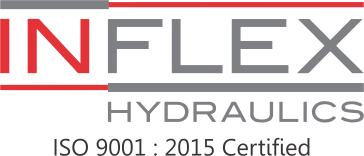When it comes to industrial operations, reliability often boils down to the smallest components—especially the hoses that handle high-pressure fluids, extreme temperatures, and vibrations. A flexible metal hose is a powerhouse in such environments, offering both durability and flexibility. But even the best metal hoses can fail prematurely if installed incorrectly.
At Inflex Hydraulics, we’ve seen time and again how avoidable mistakes can lead to equipment failure, leaks, and expensive downtimes. If you’re working with any type of metal hose pipe, this blog is your guide to getting it right from the start.
Why Flexible Metal Hoses Are the Go-To Choice
Before diving into the common installation pitfalls, let’s briefly look at why industries trust flexible metal hose systems in the first place.
These hoses are:
- Resistant to high pressure and temperature
- Corrosion-resistant
- Designed to absorb vibration and noise
- Ideal for space-constrained environments
Whether you’re in oil & gas, HVAC, chemical processing, or manufacturing, using the right hose metal setup makes a big difference.
But getting the installation wrong can quickly turn all those benefits into liabilities.
1. Choosing the Wrong Length
It might seem like a small detail, but length plays a huge role in how well your flexible metal hose performs. A hose that is too short won’t accommodate movement or thermal expansion. On the other hand, a hose that’s too long may sag, twist, or kink.
Avoid this mistake by:
- Measuring the required length precisely
- Accounting for hose movement, bend radius, and thermal growth
- Consulting experts (like our team at Inflex Hydraulics) for accurate sizing
Remember: A properly sized metal hose pipe lasts longer and performs better.
Also Read: 4 Reasons to Buy Your Hydraulic Pipe and Fittings from Inflex
2. Installing with Torsion or Twisting
Twisting a metal hose pipe during installation is one of the fastest ways to weaken it. Unlike rubber hoses, hose metal components are not designed to handle torsional stress.
Even if it seems secure initially, twisted hoses often fail over time, usually through fatigue near the fittings.
Avoid this mistake by:
- Ensuring the hose is installed without any rotation
- Holding fittings steady while tightening
- Using two wrenches—one to hold, one to turn
If your system requires any angular movement, a swivel joint or braided assembly might be more appropriate.
3. Ignoring the Minimum Bend Radius
All flexible metal hose products have a minimum bend radius, which is the tightest it can curve without risking damage. Exceeding this radius puts stress on the hose braid and corrugation, increasing the chance of rupture.
Avoid this mistake by:
- Checking the manufacturer’s specifications
- Using proper elbows or fittings instead of overbending the hose
- Installing support brackets if needed
At Inflex Hydraulics, we clearly list bend radius details for every product we offer to help you make informed decisions.
4. Failing to Account for Movement
Metal hoses are designed to flex, but they’re not magical. If you install one without considering how the equipment moves—especially in vibrating or high-motion machinery—you’ll run into trouble.
Avoid this mistake by:
- Mapping out axial, lateral, and angular movement
- Adding control units or guides
- Choosing the right braid and liner combinations based on movement type
The wrong setup can lead to leaks or even catastrophic hose failure.
5. Neglecting Proper Support
Without proper clamping or anchoring, a flexible metal hose is prone to sagging or misalignment. Over time, this stresses the fittings and causes premature wear.
Avoid this mistake by:
- Using hose clamps, anchors, or guides wherever needed
- Avoiding hanging hoses vertically without support
- Ensuring even distribution of hose weight
Especially in systems using heavier hose metal assemblies, proper support is not optional—it’s essential.
6. Mixing Incompatible Materials
It’s tempting to replace a single part with whatever is available, but mismatching materials can lead to corrosion and poor performance. Whether you’re working with stainless steel or bronze metal hoses, compatibility matters.
Avoid this mistake by:
- Matching hose material with system media
- Using compatible end fittings (threaded, flanged, or welded)
- Consulting the chemical resistance chart if transferring corrosive substances
A mismatched system may work for a while—but it will eventually fail, costing you more in replacements and downtime.
7. Poor Welding or Fitting Attachment
Improper welding or low-quality fittings can defeat the entire purpose of using a metal hose pipe. Weak welds can crack under pressure, while incompatible fittings can leak.
Avoid this mistake by:
- Working with certified suppliers like Inflex Hydraulics
- Ensuring proper inspection post-installation
- Asking for pressure testing or quality certificates
Our hoses are assembled and tested to meet industry standards, ensuring you get long-term reliability.
Recommended Reading: The Ultimate 2025 Guide to Industrial Hose and Fitting Solutions in the UAE
Why Inflex Hydraulics?
At Inflex Hydraulics, we specialize in designing and supplying flexible metal hose solutions tailored for high-performance industries. Here’s what sets us apart:
- High-grade stainless steel, bronze, and other alloys
- Custom lengths and fittings on request
- Precision-braided and pressure-tested assemblies
- Support from experienced engineers and application experts
Whether you’re ordering for a one-off project or outfitting an entire plant, we make sure your metal hoses are built to last.
Final Thoughts
Installing a flexible metal hose might seem straightforward—but small oversights can lead to big problems. By avoiding these common mistakes, you can maximize the lifespan, safety, and performance of your entire system.
From incorrect sizing to poor support, each misstep weakens the hose and increases the risk of failure. But with the right knowledge—and the right partner—you can ensure that your metal hoses do exactly what they’re meant to: perform under pressure.



